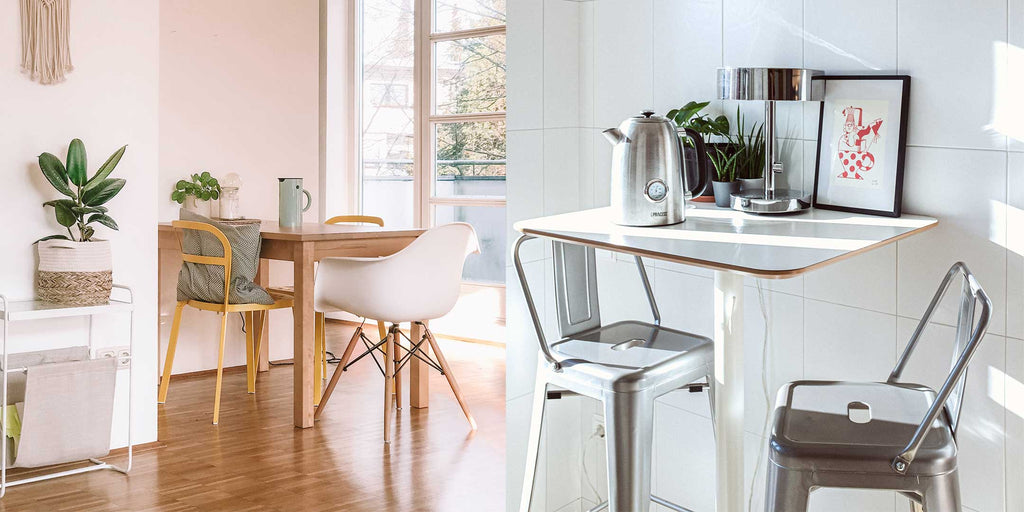Your kitchen can either be the catchall for the most random items in your home or a dusty place you barely focus on when having a major home makeover. Since your dining room, especially your dining table's surface, is very accessible but less used, clutter can quickly pile up without you even noticing. Newspapers, receipts, grocery bags, knick-knacks, lost crayons—even the smallest of things can take up so much space in your dining area when collected.
If your dining room starts to be the home of clutter, it's high time you make a move and restore your meal and bonding place. Whether you are redesigning your dining room or freeing up some space for upcoming guests, here are some practical ways to organise your dining area and turn it into a place you will surely adore.
Before Anything Else: Declutter

We have this general decluttering rule at Megafurniture: take out your three big boxes and get ready to mercilessly declutter. When decluttering, your aim is to free up as much space as possible and remove stuff that isn't supposed to stay in your dining area. So, first things first, take out all the items in your dining room and sort them into three big boxes: one for donating, one for tossing out, and the other for the stuff that will remain in your home. We suggest that you do this with other people in your home so that they can help you move heavy or broken items and get used to the new dining room layout.
Take note of these things that you can toss off when decluttering:
-
Broken items that can't be repaired
-
Expired food
-
Old newspapers
-
Expired coupons
-
Takeout Menus
-
Flyers
Here are the items you can donate:
-
Appliances that you don’t use but others can
-
Gifted items that you never use
-
Decors that you don’t need
While freeing up so much space, decluttering will also help you assess your furniture and storage needs and envision the new look you want to achieve.
Assess Your Dining Room

We trust that you are left with everything you need in your dining room. Now that you have only the essential items, you can plan the layout of your dining room as well as your storage needs. While decluttering, did you feel the need to buy new storage furniture? Did you envision adding other functions to your dining room? If you have an open-concept kitchen, do you plan to section off your kitchen and dining space?
For a Dining Room that Doubles Up as a Study Area

Since fewer activities are done in your dining room, you can turn it into a temporary study area. Your dining table and chairs are great places to sit and do homework and projects, as they are spacious enough to accommodate many items. Keep your essentials inside a basket or a storage cabinet to prevent school supplies from cluttering your dining table. Once the homework time is done, make sure to keep everything in its designated storage to prepare your table for the meal. If you are working from home, you can turn your dining room into a home office when it is not in use.
Open-Concept Kitchen

If you've run out of storage in your kitchen, you can transfer some items like flatware, silverware, seasonal kitchen appliances, and other dining essentials that you can't fit in your kitchen cabinet into your dining area. You can set up a free-standing buffet hutch in your dining room for your cutlery sets and small-to-medium kitchen appliances. A rack or an easy-to-pull-out cabinet with casters is a great storage choice for smaller items that you need fast access to, like pantry supplies. If you don’t have enough space, it’s always good to utilise the less-used areas of your kitchen and dining room to make your space more connected and purposeful.
Time to Organise

Once you get a good view of your space and its function, it's time to repurpose and organise.
Dining Room Storage Needs

Your storage depends on the amount and size of items that you have. If you host often, chances are you have lots of cutlery sets and glassware. A combination of pull-out and glass-door shelving will help you organise your collections in a way that you can display them. For formal gatherings, a sideboard or credenza is an excellent go-to, as it provides ample storage space for essentials and a surface for food.
Here are some excellent storage furniture pieces you can use for your dining area:
- Bar or utility cart for your beverages, condiments, and glassware
- Wall shelves for items you want to access easily
- Cubby holes for small to medium dining room essentials
- Pull-out drawer cabinet to safely keep utensils and cutlery
- A dining table with built-in storage for a multifunctional space
- Ottoman dining bench with concealed storage
Some more items you can use to store are:
- Sorting boxes
- Modular drawers
- Bins and jars
Dining Room Decoration

When organising your dining room, it's vital to note the look and ambiance you want to achieve. Your furniture choice, your dining set design, and the colour combinations all play significant roles in setting up the look and feel of your space. You can also express your style through your kitchen and dining room storage. A good way to express a modern dining room is by using wooden furniture and keeping the clutter away or hidden as much as possible. Since modern design leans on minimalism, your furniture will most likely be limited to your dining set and storage furniture. For a more casual look, you may install open shelves where you organise your kitchen and dining essentials together with some decorative pieces. Just note that items placed on open shelves are more prone to accumulating dust than those kept inside the cabinet. Incorporating decorative elements like framed wall decor and vases makes your dining room more inviting.
Remember, decluttering and buying dining room furniture and essentials don't have to happen all at once. During our fast-paced schedules, it's helpful to spend at least fifteen to thirty minutes a day going through your items to take out what you don't need, or dedicate a weekend to decluttering and bonding. Decluttering and organising can be so much fun when done creatively.



